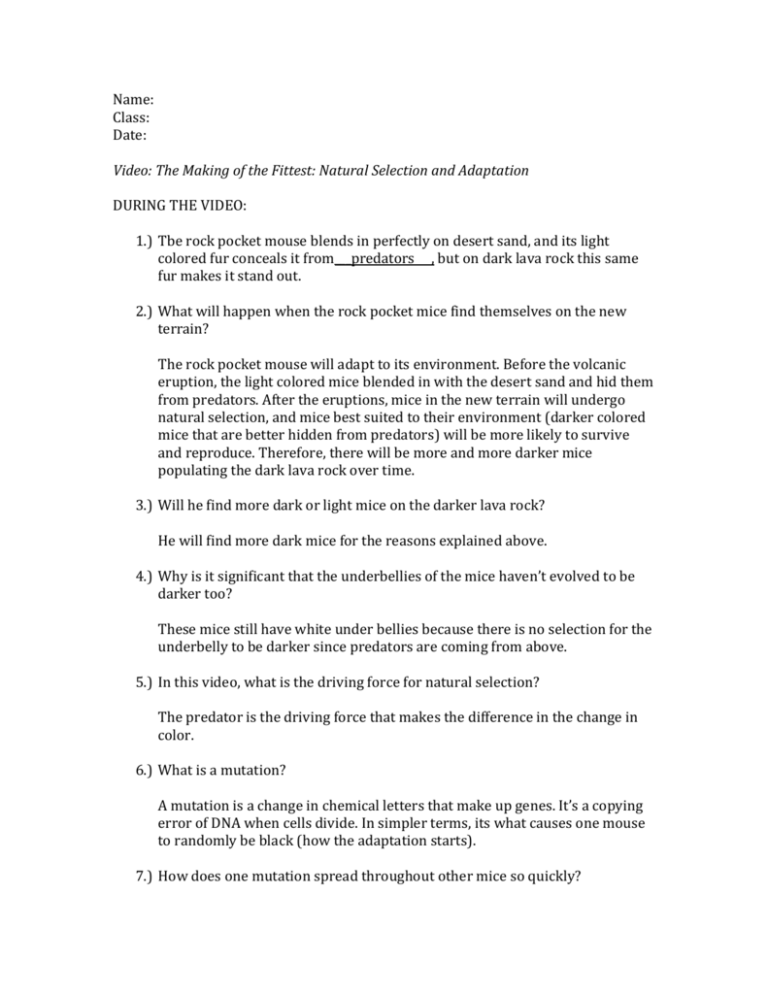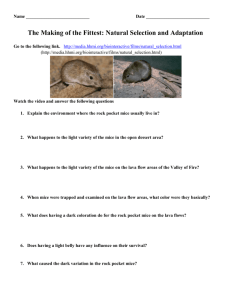The Making of the Fittest Video Answers
advertisement

Name: Class: Date: Video: The Making of the Fittest: Natural Selection and Adaptation DURING THE VIDEO: 1.) Tbe rock pocket mouse blends in perfectly on desert sand, and its light colored fur conceals it from___predators , but on dark lava rock this same fur makes it stand out. 2.) What will happen when the rock pocket mice find themselves on the new terrain? The rock pocket mouse will adapt to its environment. Before the volcanic eruption, the light colored mice blended in with the desert sand and hid them from predators. After the eruptions, mice in the new terrain will undergo natural selection, and mice best suited to their environment (darker colored mice that are better hidden from predators) will be more likely to survive and reproduce. Therefore, there will be more and more darker mice populating the dark lava rock over time. 3.) Will he find more dark or light mice on the darker lava rock? He will find more dark mice for the reasons explained above. 4.) Why is it significant that the underbellies of the mice haven’t evolved to be darker too? These mice still have white under bellies because there is no selection for the underbelly to be darker since predators are coming from above. 5.) In this video, what is the driving force for natural selection? The predator is the driving force that makes the difference in the change in color. 6.) What is a mutation? A mutation is a change in chemical letters that make up genes. It’s a copying error of DNA when cells divide. In simpler terms, its what causes one mouse to randomly be black (how the adaptation starts). 7.) How does one mutation spread throughout other mice so quickly? While only 1 new mouse born in 100,000 may be black, hundreds of thousands of mice are born a year, and black mice have advantage. This advantage (blending in with the environment so they’re less visible to predators) allows black mouse babies do better (they’re more likely to survive and reproduce) and the same goes for their offspring and so on. Thus, the advantage can quickly turn whole population black. 8.) Is evolution random? Mutation? Natural selection? Mutations occur randomly, but natural selection isn’t random because it sorts out winners and losers (who’s better fit for their environment) which drives evolution. Proof: natural selection produces same result under same conditions. 9.) “As environments transform so must the species that inhabit them: adapting and readapting in the great and complex battle of life” AFTER THE VIDEO: 1.) Using the knowledge you gathered from the video and your discussion with your classmates, define natural selection: The process by which forms of life having traits that better enable them to adapt to specific environmental pressures, as predators, changes in climate, or competition for food or mates, will tend to survive and reproduce in greater numbers than others of their kind, thus ensuring the perpetuation of those favorable traits in succeeding generations. 2.) Predict how a population of insects might change over time if farmers started using pesticides to prevent the insects from eating their crops. The insects will gradually become resistant to the pesticides due to natural selection. The insects that contain a mutation that allows them to survive despite pesticide presence will be selected for. These insects will survive and reproduce until eventually all of the insects in the population will be pesticide resistant. 3.) Explain the role of mutation in natural selection and give an example. Mutation, which is random, is necessary for natural selection and evolution to occur. Natural selection selects the genetic mutations that make the organism most suited to its environment and therefore more likely to survive and reproduce. 4.) Using what you know about natural selection, what do you think “artificial selection” is? Hint: think about selective breeding of dogs. Artificial selection is the process in which humans consciously select for or against particular features in organisms. For example, the human may allow only organisms with the desired feature to reproduce or may provide more resources to the organisms with the desired feature. This process causes evolutionary change in the organism and is similar to natural selection, only with humans, not nature, doing the selecting Bonus Question: Now you know what natural selection is, but there are actually a few different kinds of natural selection, some of which are listed below. Try your best to use what you learned in class today to define these: Directional Selection: directional selection is a mode of natural selection in which one extreme trait is favored. Disruptive Selection: describes changes in a population in which extreme values are favored Standardizing Selection: the opposite of disruptive selection, genetic diversity decreases and the mean stabilizes on a particular trait in the middle, not the extremes







